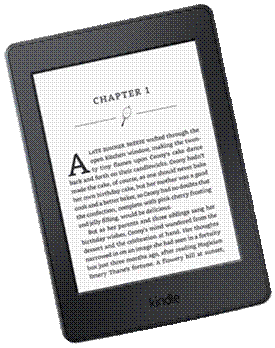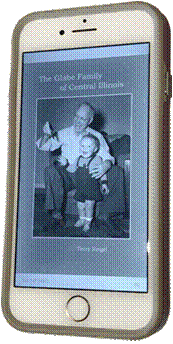
This page created 24 Jun 2019
Version note: Applies to Gedcom Publisher 1
This article is intended to provide a general understanding of what e-books are, and how they differ from other types of electronic publications, so that readers are better prepared to create them with Gedcom Publisher. Other articles in my Gedcom Publisher Section cover more specific topics about using the program.
|
Topics Included in this Article |
|
| The basic concept of an e-book | |
| How these two electronic formats compare | |
| How two common electronic formats compare | |
| Arranging the content of you e-book | |
| Common e-book file formats | |
Fundamentally, an e-book is a digital file designed to be displayed in an electronic reader, or e-reader. Typically e-readers are small hand-held devices meant to be highly portable. They may be dedicated devices used only to display e-books, such as Amazon's Kindle:
Other hand-held devices, such as smart phones and tablets typically include capability to display e-books:

Less commonly, laptop or desktop computers are used. They require the installation of an application designed to display the e-book files. While not as convenient as the highly portable hand-held devices, they are very useful for proofing an e-book while under development with Gedcom Publisher. For more on using a computer to view e-books see Installing a Reader section of my Getting Started with Gedcom Publisher article.
In the following two sections we explore how e-books compare to two other common types of electronic media.
The Portable Document Format, or PDF, has been used for many years. The table below summarizes some of the key differences between e-books and PDF files:
| e-books | |
|---|---|
| Designed for books on small screens | Designed to maintain layout and formatting of documents displayed or printed on different systems |
| Adjusts layout to fit screen size | Maintains the designer's layout, so may be too small to read on small screens |
| Reader can adjust font size and style, colors, and more | Creator controls all formatting |
In short, the e-book is designed to optimize the reader's experience in viewing book-like material on a small screen, while the PDF is designed to maintain the intended formatting of documents, such as forms and flyers, no matter what platform is used to display or print them.
Another common form for viewing information electronically is the website. While e-books share many characteristics with web pages, there are some key differences, as outlined in the following table:
| e-books | Websites |
|---|---|
| Designed for books on small screens | Designed to utilize rich feature sets |
| Suitable for a variety of reader hardware, especially hand-held devices | Suitable for computers, tablets, and with issues, smart-phones |
| Contained in a single file, thus easy to share | Composed of very many files, thus best viewed from an Internet host or a detachable storage device (thumb drive) |
| Large images and complex pages work poorly due to typically small screen sizes | Complex pages work when displayed on screens of ample size; accommodations required for small screens. |
In short, e-books are optimal for reading text and simple content such as small images, while websites excel at displaying a rich mix of text, images, tables, videos, and interact well with other Internet resources.
The following table outlines some additional differences between e-books and websites that may be of interest to users interested in customizing the e-books they create:
| e-books | Websites |
|---|---|
| Support for Internet links varies among reader devices | Support links to a rich variety of external web services |
| Uses HTML and CSS but support varies significantly among readers | Uses HTML and CSS with stable support among current browsers |
Web browsers have matured substantially over the past decade or so, and designers can employ various techniques with confidence that readers using various browsers will experience the intended result. In contrast, e-book are currently much less mature and have significantly different capabilities from one another. For example, some readers can display webpages called by links in the e-book, others transfer the linked content to a web browser installed on the device, while still other simply ignore the link. However links to targets within the book work in all readers, and enable indexes with live links, cross-references, and access to related content just as with websites.
Likewise, HTML and CSS elements beyond the more basic types are supported to varying degrees by e-readers. Some readers may display a particular element as intended while others will ignore the specified styling totally.
There seems to be a general consensus that readers of e-books expect them to be read like paper books, and not like websites. That is, while internal links enable content in other parts of the book, readers seem to generally want to read the book from front to back as they do a paper book. This places an expectation of the creator of the book to organize the content in some logical fashion that will make sense to the reader.
This expectation will be familiar to those accustomed to creating paper reports or books, but less so to those who have previously published on a website. Websites generally provide some introductory material and then offer a variety of navigation paths to the reader by use of links to other content. In fact, for websites accessed on the Internet, many readers may access content directly by use of search engines and bypass the introductory material altogether.
These factors suggest several separate considerations in organizing an e-book with genealogical content:
Files for e-books consist of a single large file, thus are easily shared with users. Those technically inclined may be interested to know that the single e-book file is a container for a set of files and directories and uses the same format as ZIP file archives.
While there are a number of file formats used for e-books, two formats are dominate:
Gedcom Publisher produces files in the EPUB format. Amazon offers a program called KindleGen which can generate a MOBI format e-book file from an EPUB file. Gedcom Publisher produces a special EPUB file for this purpose which is optimized for the conversion. For details on this see the Gedcom Publisher Help Page on the subject.
| ReigelRidge Home | Terry's Tips Home | Contact Terry |
Copyright 2000- by Terry Reigel